 W
WA beaker is a beverage container, typically of non-disposable plastic, or a ceramic cup or mug without a handle, much like a laboratory beaker.
 W
WA Berkemeyer is a drinking glass with a wide, flared bowl, dating from 15th-century Germany and the Netherlands, and still made today. They have a characteristic green or yellow colour caused by iron impurities in the sand used for glass production. The thick, hollow stem is covered with prunts providing a secure grip for hands greasy from feasting, similar to the römer.
 W
WA bota bag is a traditional Spanish liquid receptacle, used mainly as a wineskin. It is often made out of leather, and is typically used to carry wine, although any liquid can be filled into it. Often referred to as a canteen.
 W
WA bridge-spouted vessel is a particular design of ewer originating in antiquity; there is typically a connecting element between the spout and filling aperture, and the spout is a completely independent aperture from the usually smaller central fill opening. Early incidences of the bridge-spouted vessel are found in Persia in the early Iron Age and on Crete. This type of vessel typically appears in the Bronze Age or early Iron Age. A very early example of a bridge-spouted bowl has been recovered at the ancient palace of Phaistos on Crete, dating to the Bronze Age.
 W
WA Briq, Ibrik or Brik is an ancient teapot and pitcher traditionally used by the inhabitants of Lebanon and west Syria to prepare and drink tea or water. It is a pot and handle with a unconventional spout that allows liquid to be consumed easily with no receptacle and tea to be mixed effectively and conveniently. It is traditionally earthenware, however glass briqs are also common.
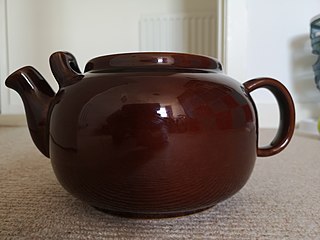 W
WA Brown Betty is a type of teapot, round and with a manganese brown glaze known as Rockingham glaze.
 W
WA canteen is a drinking water bottle designed to be used by hikers, campers, soldiers and workers in the field of the people in the early 1800s. It is usually fitted with a shoulder strap or means for fastening it to a belt, and may be covered with a cloth bag and padding to protect the bottle and insulate the contents. If the padding is soaked with water, evaporative cooling can help keep the contents of the bottle cool. Many canteens also include a nested canteen cup.
 W
WClosure is a term used in the wine industry to refer to a stopper, the object used to seal a bottle and avoid harmful contact between the wine and oxygen.
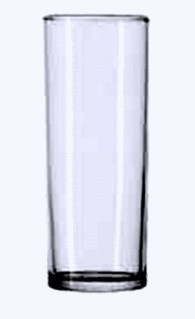 W
WA collins glass is a glass tumbler which typically will contain 300 to 410 millilitres. It is used to serve mixed drinks, especially Tom Collins or John Collins cocktails. It is cylindrical in shape and narrower and taller than a highball glass. An example size is 2 1⁄2 in (6 cm) diameter by 6.75 in (17 cm) in height.
 W
WThe crown cork, the first form of bottle cap, was invented by William Painter in 1892 in Baltimore. The company making it was originally called the Bottle Seal Company, but it changed its name with the almost immediate success of the crown cork to the Crown Cork and Seal Company. It still informally goes by that name, but is officially Crown Holdings. Crown corks are similar to the Pilfer proof caps, as usage of both products is to seal the bottle.
 W
WA demitasse or demi-tasse is a small cup used to serve Turkish coffee or espresso. It may also refer to the contents served in such a cup.
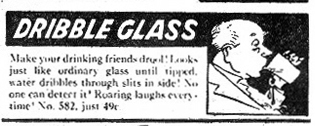 W
WA dribble glass is a drinking glass that has holes hidden in its etched design.
 W
WA fuddling cup is a three-dimensional puzzle in the form of a drinking vessel, made of three or more cups or jugs all linked together by holes and tubes. The challenge of the puzzle is to drink from the vessel in such a way that the beverage does not spill. To do this successfully, the cups must be drunk from in a specific order.
 W
WThe gasogene is a late Victorian device for producing carbonated water. It consists of two linked glass globes: the lower contained water or other drink to be made sparkling, the upper a mixture of tartaric acid and sodium bicarbonate that reacts to produce carbon dioxide. The produced gas pushes the liquid in the lower container up a tube and out of the device. The globes are surrounded by a wicker or wire protective mesh, as they have a tendency to explode.
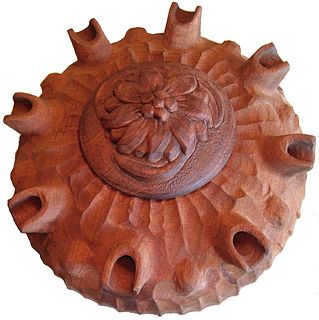 W
WA grole is a multi-spouted, and often ornately carved, wooden bowl with a small lid. Groles are always round and relatively shallow, with an interior capacity for liquid proportionate to the number of spouts.
 W
WGuksi is a type of drinking cup traditionally duodji crafted by the Sami people of northern Scandinavia from carved birch burl.
 W
WA highball glass is a glass tumbler that can contain 240 to 350 millilitres. It is used to serve highball cocktails and other mixed drinks. An example size is 7 cm (3 in) diameter by 15 cm (6 in) in height.
 W
WHolloware is metal tableware such as sugar bowls, creamers, coffee pots, teapots, soup tureens, hot food covers, water jugs, platters, butter pat plates, and other items that accompany dishware on a table. It does not include cutlery or other metal utensils. Holloware is constructed for durability. It differs from some other silverplated items, with thicker walls and more layers of silverplate.
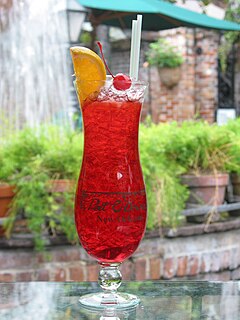 W
WA Hurricane glass is a form of drinking glass which typically will contain 20 US fluid ounces. It is used to serve mixed drinks, particularly the Hurricane from which it is named originating at Pat O'Brien's Bar in New Orleans. Other drinks served in this glass include the Singapore Sling, June bug, Piña colada and Blue Hawaii. It is shaped similarly to a vase or a hurricane lamp and is typically taller and wider than a highball glass.
 W
WThe Kovsh is a traditional drinking vessel or ladle from Russia. It was oval-shaped like a boat with a single handle and may be shaped like a water bird or a Norse longship. Originally the Kovsh made from wood and used to serve and drink mead, with specimens excavated from as early as the tenth century. Metal Kovsh began to appear around the 14th century, although it also continued to be carved out of wood and was frequently brightly painted in peasant motifs. By the 17th century, the Kovsh was often an ornament rather than a practical vessel, and in the 19th century it was elaborately cast in precious metals for presentation as an official gift of the tsarist government.
 W
WA kyūsu (急須) is a traditional Japanese teapot mainly used for brewing green tea.
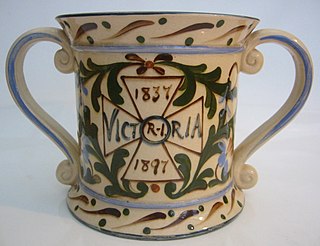 W
WA loving cup is a shared drinking container traditionally used at weddings and banquets. It usually has two handles and is often made of silver. Loving cups are often given as trophies to winners of games or other competitions. They can be found in several European cultures, including the Celtic quaich and the French coupe de mariage.
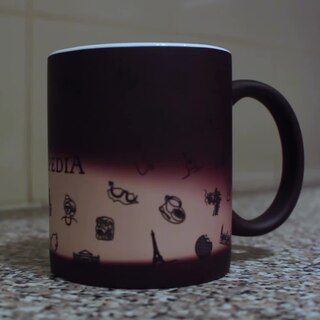 W
WA magic mug, also known as a heat changing mug, is a mug that changes colour when it is filled with a hot liquid. This effect is created by using thermochromic ink.
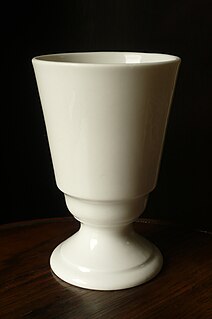 W
WMazagran is a kind of drinkware usually used for coffee, which is named after the town of Mazagran in Algeria.
 W
WThe moustache cup is a drinking cup with a semicircular ledge inside. The ledge has a half moon-shaped opening to allow the passage of liquids and serves as a guard to keep moustaches dry. It is generally acknowledged to have been invented in the 1860s by British potter Harvey Adams.
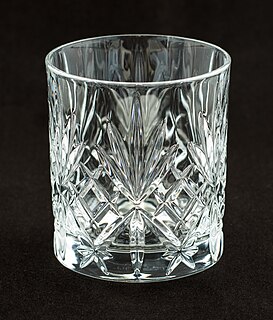 W
WThe old fashioned glass, rocks glass, lowball glass, is a short tumbler used for serving spirits, such as whisky, neat or with ice cubes. It is also normally used to serve certain cocktails, such as the old fashioned, from which it receives its name.
 W
WA penny lick was a small glass for serving ice cream, used in London, England, and elsewhere in the late nineteenth century and early twentieth century. Street vendors would sell the contents of the glass for one penny. The glass was usually made with a thick glass base and a shallow depression on top in which the ice cream was placed. The customer would lick clean the glass and return it to the vendor, who would reuse it.
 W
WA piyāla, also called piola, piyola, piala or chini is a small ceramic bowl used throughout Central Asia for drinking tea. It is similar to the East Asian chawan. Piyālas may be used for other beverages too, such as kymyz, though traditionally a full-size bowl is used for cold and hot beverages.
 W
WA saucer is a type of small dishware. While in the Middle Ages a saucer was used for serving condiments and sauces, currently the term is used to denote a small plate or shallow bowl that supports a cup – usually one used to serve coffee or tea. The center of the saucer often contains a depression or raised ring sized to fit a matching cup; this was only introduced in the mid 18th century. The saucer is useful for protecting surfaces from possible damage due to the heat of a cup, and to catch overflow, splashes, and drips from the cup, thus protecting both table linen and the user sitting in a free-standing chair who holds both cup and saucer. The saucer also provides a convenient place for a wet spoon, as might be used to stir the drink in the cup in order to mix sweeteners or creamers into tea or coffee.
 W
WA schooner is a type of glass for serving drinks. In the United Kingdom it is the name for a large sherry glass. In Australia it is the name for a particular glass size, used for any type of beer.
 W
WThe sippy cup, training cup, or beaker is a drinking cup designed for toddlers which prevents or reduces spills. Sippy cups, as opposed to an open cup, have a top which prevents spills, and the child drinks either through a spout or straw. Some sippy cups work by way of surface tension that prevents liquid from being spilled even when the cup is upended, and others have valves. A sippy cup is typically an intermediary between the transition between the bottle or breast to an open cup; however, some recommend skipping the sippy cup and transitioning directly to an open cup.
 W
WA snifter is a type of stemware, a short-stemmed glass whose vessel has a wide bottom and a relatively narrow top. It is mostly used to serve aged brown liquors such as bourbon, brandy, and whisky.
 W
WStemware is drinkware that stands on stems above a base. It is usually made from glass, but may be made from ceramics or metals. The stem allows the drinker to hold the glass without affecting the temperature of the drink.
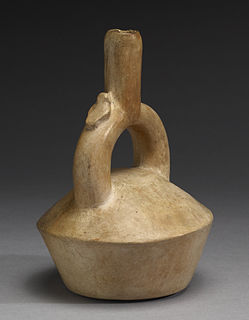 W
WA stirrup spout vessel is a type of ceramic vessel common among several Pre-Columbian cultures of South America beginning in the early 2nd millennium BCE.
 W
WA tasse à café is a cup, generally of white porcelain and of around 120 ml, in which coffee is served. It is also sometimes used to serve small portions of rich drinks, such as hot chocolate
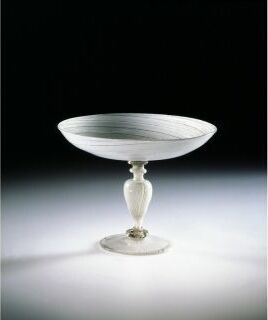 W
WA tazza is a wide but shallow saucer-like dish either mounted on a stem and foot or on a foot alone. The word has been generally adopted by archaeologists and connoisseurs for this type of vessel, used either for drinking, serving small items of food, or just for display. Tazze are most commonly made in metal, glass, or ceramics, but may be made in other materials.
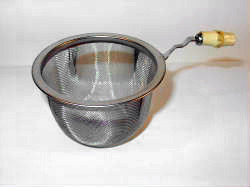 W
WA tea strainer is a type of strainer that is placed over or in a teacup to catch loose tea leaves.
 W
WA tumbler is a flat-bottomed beverage container usually made of plastic, glass or stainless steel.
 W
WVolcano bowls are ceramic drinkware originally associated with mid-20th century American tiki bars and tropical-themed restaurants. Drinks served in volcano bowls are typically rum-based, mixed with tropical fruit juices and other liquors such as brandy, vodka, and triple sec, and garnished with fruit. The Flaming Volcano cocktail is especially associated with this drinkware.
 W
WA wineskin is an ancient container made of animal skin, usually a goat, used to transport liquids such as water, olive oil, milk, wine, butter or even cheese.
 W
WA yunomi is a tall form of Japanese teacup, typically made from a ceramic material and having no handle.